| |
An eccentric set of firsts, lasts, oddities, and superlatives for my ode year 2007. A longish but hopefully entertaining page: |
First ode: Pacific Forktail
10 March at Laguna Grande Park, Seaside MTY
This photo 7 Aug 2007 Laguna Grande
I
started looking for odes the first week of March, and checked Laguna
Grande on 5 March (nada). That was the start of a weekly survey at
Laguna Grande for 36 weeks (though 4 Dec) as part of Jason Bried's
continent-wide survey project.
|
|
|
Last ode: five species
3 Dec at Carmel River mouth
photos (left) taken 3 Dec 2007
Familiar
Bluet, C. Green Darner, Blue-eyed Darner, Variegated Meadowhawk (far
left), Cardinal Meadowhawk (near left). One each except there were five
bluets (4 males, 1 female)
|
Last 'new' ode for year: Striped Saddlebags
13 Oct at 'Squaw Pond' near Squaw Lake IMP
This
was my only 'vagrant' for the year, but since we found two widely
separated individuals in two days, it may prove to be a regular
wanderer to southeast CA in October. I planned a trip in mid-Oct to
look for vagrants because of the success of 'Ode Blitz II' in Oct 2006.
Details of our trip elsewhere.
|
|
|
Most common dragon: Blue-eyed Darner
This male 2 Oct at Laguna Grande
My first Blue-eyed Darner was on 7 Apr, and it became progressively more common as summer progressed.
It was seen at 24 of the 66 sites visited during the year (36% of all
sites visited). The last was seen 3 Dec (Carmel R. mouth).
|
Most common damsel: Vivid Dancer
This tandem 29 May at Laguna Grande MTY
If
"common" means widespread, this abundant damsel is it; I found it at 31
of the 66 sites I visited (47%). I saw it as early as 15 March and as
late as 3 Nov. In pure numbers, though, several forktails (Pacific,
Western, Rambur's) were in the running.
|
|
|
Most surprisingly oft-seen ode: California Darner
This photo 26 Mar at Laguna Grande
When
Rita & I ventured out odeing for the first time ever on 5 July 2006
— the summer before my 'big year' — I found a California Darner for the
"first" record for Monterey County. We never saw another in 2006. Thus
I was very surprised to see it "everywhere" in Apr-June 2007, including
at a Giants' baseball game in San Francisco, where it perched on
oblivious fans!
|
Rarest ode (non-vagrant): Ringed Emerald
22 July at Gumboot Lake SIS
Rita
spotted this emerald at roost in a small pine rather early in the
morning for odes; we would never see another. While its known CA
distribution continues to expand with surveys in the Trinity Alps, most
spots are difficult to reach. The species remains difficult and erratic
in California.
|
|
|
Most dramatic ode: ovipositing Pacific Spiketail
22 July along Gumboot Creek SIS
We
were so lucky to watch this performance. Eric Preston described one he
watched in 2004 as looking 'like she was on a pogo stick or at the end
of yo yo string' as she repeatedly plunged her ovipositor into the sand
below the water's surface. Our female performed for perhaps 3-5
minutes; more photos and story on another page.
|
Most beautiful ode: River Jewelwing
9 June along north fork Pit River MOD
There
are really many truly lovely dragons & damsels, from the delicate
shadings of the tiny Taiga Bluet to the bright pinks of Roseate
Skimmer, but I must say that when sees the first River Jewelwing ever,
one is awestruck with speechless wonder. No photos really capture this
because the body is metallic iridescence of constantly changing color,
and the moving wings are so dramatic.
|
|
|
Most unexpected ode: Western River Cruiser
6 May along upper San Antonio River MTY
There
were no prior records anywhere near Monterey County when Paul Johnson
& I encountered this cruiser in flight on 6 May. The species wasn't
even 'on my radar' for potential new county odes. We found four, and
some were present the next weekend for Rita and Steve Rovell. This
saved me several planned trips elsewhere later in the summer.
|
Most famous ode: Pacific Clubtail
29 April on upper San Antonio River MTY
This clubtail face-off with a bullfrog make the cover of the July 2007 issue of Argia, the news journal of the Dragonfly Society of the Americas. My little article on "Saving (my) Private Clubtail" was at Argia 19(2):7. The clubtail was only the 2nd record for MTY.
|
|
|
Favorite ode: Bison Snaketail
12 May at upper San Antonio River MTY
Gotta
love a dragonfly with horns, as does female Bison Snaketail, but
discovering the species in two unexpected MTY locales just added to its
image. Indeed, snaketails are my favorite genus and finding each of the
State's four species was a treat. Here's my shot of all four together
(below)
|
|
|
| Okay,
so you figured out that the above photo is a fake — a PhotoShop collage
— but the start of the year was really superb, including finding all
four snaketails. As the year progressed, things sometimes went
according to plan — and other things did not. To surpass the prior CA
record of 204 species, I needed to see every resident ode in
California, save one, or get a vagrant. I missed Belted Whiteface at
Willow Lake in July and August, which meant I needed to find every
other regular CA ode from that point on. This put a lot of pressure on
finding all the late-flying species. |
Most surprisingly late ode: Variegated Meadowhawk
This photo 23 Sep below San Antonio Dam MTY
On the annual ode reports on Kathy Biggs' web site,
Variegated Meadowhawk is often the first ode of the year. In 2007,
David Blue in San Diego Co. and Ray Bruun in Shasta Co. saw this
meadowhawk on 1 January. My first Variegated for the year was not until
4 July — my 71st ode species of the year. Of course, I was never
worried about this one . . .
|
|
|
The missing ode: Belted Whiteface
this scan from Dennis Paulson's web pages
Tim
Manolis discovered this boreal species at Willow Lake in 1998. It was
found consistently there during July-August through 2005, but I missed
it entirely on three Willow Lake trips in 2007. Willow Lake still
remains its only known locale in California.
|
Most gratifying ode: Spiny Baskettail
8 June at Blue Lake LAS
In recent times, Spiny Baskettail is known from only one spot: Blue Lake in the extreme northeast corner of Lassen Co (specimens were taken 90 years ago at Donner Lake but none there since). So my June trip to Blue Lake was critical — and it was immensely gratifying to find a couple of newly-emerged baskettails!
|
|
|
First troublesome ode: Black Petaltail
22 July near Picayune Lake TRI
Kathy
& Dave Biggs had reported many petaltails at seeps along the road
to Picayune Lake on 25 July 2006. "It actually got to the point where
we'd say 'what was that? Oh just another petaltail'," Kathy wrote. We
tried on 22 July 2007. Tried seep after seep and . . . nothing. I
climbed way up and found this one only.
|
"Oh Happy Day" combo: Brimstone & Russet-tipped Clubtails
3 Aug at westside Main Canal nr Calexico IMP
Among the "six serious problems"
anticipated for the year were these two southern clubtails. The best
shots were during the peak of the heat and humidity in the Imperial
Valley — a long way from home for me — and so I really had only one
reasonable shot. It took all day, an air-conditioned rental car, and
Paul Johnson's advice to make it happen . . . but both were found.
|
|
|
Mildly stressful ode: Desert Whitetail
11 Aug near Whitmore Hot Springs MNO
Missed
Desert Whitetail at Dos Palmas in May. Missed it at Zamboni Hot Springs
in June; missed it there again in July. I was getting mildly nervous
about this one by the time of Ode Blitz III, but fortunately the
Biggs's knew a great spot in Mono Co. with dozens of them.
|
Most stressful ode: Neon Skimmer
14 Aug at Morongo Valley SBE
The
stress level on this one was a lot higher. I missed it at sites where
it was reported in prior years in Imperial, San Diego, Inyo, and Shasta
counties. The dry year seemed to have reduced its numbers. But Pete
Siminski reported a couple at Morongo Valley in August and, although
this was a long way away, Pete's tip did lead to finding two different
males there.
|
|
|
Hardest ode: Lavender Dancer
25 Aug on the upper San Benito River SBT
Tim
Manolis (in 1999) and Hall & Edwards (in 2005) had missed Lavender
Dancer on their 'big years.' I missed it at Sweetwater Creek SD and
Piru Creek LA, spots where it had been found in recent years. It was
only through the help of Paul Johnson, who had discovered some in truly
remote locales in San Benito Co. in recent years, and a major effort
with Paul on 4-wheel drive roads, that led to success.
|
Make-or-break ode: Canada Darner
8 & 9 Sep at Willow Lake PLU
By the end of August it was clear that I could reach my goals if I found the 4 regular odes remaining: two late Archilestes
spreadwings, Autumn Meadowhawk, & Canada Darner. I thought the
darner would be the hardest — and it was. In two days and 11 hours at
Willow Lake in September, I got one bad flight photo of a male and Ray
Bruun netted this female.
|
|
|
Most expensive ode: Great Spreadwing
29 Sep at Copeland Creek @ Lichau Rd SON
I
anticipated this would be the final ode of the year, and planned for it
at Cold Canyon, Solano Co., but a visit there on 10 Sep found the creek
completely dry. So I got nervous and drove all the way to Santa Barbara
Co. in late Sept to try Refugio Creek. It was cool & overcast and I
saw no odes had all. Rather, I had to shell out big bucks to stay in
the last motel room left in Goleta on Saturday night, and then missed
it the next day as well. I finally had to drive north to Petaluma in
Sonoma County to finally connect with this late season species. Other
places were farther away but the costs were split among numerous
species. This was one d—d expensive bug.
|
Most useful odes: range extensions
Efforts this year resulted in some scientifically useful data, including first Monterey County records of Western River Cruiser (with Paul Johnson), Exclamation Damsel (with Rita Carratello), and Aztec Dancer (right),
plus four more that were 2nd MTY records, in addition to first records
for Mono County and even Esmeralda County, Nevada. . .
|
|
|
| The
year wasn't all odes. Sure, they were the primary focus but basically I
love the travel, adventure, and joy of seeing new places and learning
new stuff. Here were some superlative sidelights: |
Most lovely new spot: Ash Creek Campgr LAS
Only
places I'd never seen before qualified for this category. Tim Manolis
had 'discovered' Ash Creek Campground in northwest Lassen Co. some
years before. I visited twice in 2007. It is lovely in so many ways,
and is "Gomphid City" [see separate page]. Gumboot Creek SIS is a very close second.
|
|
|
Strangest physical condition: sun at Willow Lake
This
photo, taken at 10 a.m. on 8 Sep at Willow Lake without any filter,
shows the effect of forest fires to the east on the mid-morning sun.
The entire sky was red and the smoke particles so dense that the sun
could be viewed with the unaided sky. The odes didn't like it, and
remained hidden until the afternoon breeze diminished the smoke and the
day warmed.
|
Best bird seen while odeing: California Condor
Two condor encounters in 2007 were vaguely connected with odeing. Enroute home from Piru Creek
on 16 Aug, we watched 3 condors circling against the smoke from the
Zaca Fire (near right). The next day we watched a condor nest in the
Ventana Wilderness (far right) where the chick made brief appearances
at cliff's edge. Walker's Darner worked the creek below us.
As to vagrants, I found Summer Tanager (near right) & Black-and-white Warbler (far right) at Laguna Grande, MTY, while doing ode surveys for Jason Bried's project this year (both in October).
|
|
|
Best mammal while odeing: Siskiyou Chipmunk
22 July at Gumboot Creek SIS
I
spent a lot of time outdoors while odeing in 2007, and had encounters
with deer, elk, pronghorn, bobcat, coyote, badger, and muskrat, among
others, but I'll chose the only new mammal lifer of the year as the
year's "best while odeing."
|
Best herp while odeing: Foothill Yellow-legged Frog
30 June in San Lorenzo River MTY
This
once widespread species is now considered 'threatened' in California.
Limited to undisturbed foothill streams, my discovery of its presence
in the San Lorenzo River, east of King City, added a new watershed to
its currently known range.
|
|
|
Most impressive plant: California Pitcher Plant
22 July at Gumboot Creek SIS
Darlingtonia californica,
also Cobra Lily, is a carnivorous plant, the sole member of the genus
in the family Sarraceniaceae. Endemic to northern California and
Oregon, and growing in bogs and seeps with running water, it was soooo
impressive to see it growing in profusion. The sundews at Willow Lake, another carnivorous plant, were a close second.
|
|
| Finally, just some oddities and funny stories . . . |
Most odes ovipositing at one spot: California Dancer
5 tandems on one reed
25 Aug in San Lorenzo River MTY
California
Dancers seems to have an affinity to oviposit side-by-side like this,
although Northern Bluets on the San Antonio River in May were not shy
about such close quarters either . . .
|
|
|
Most comical ode: White-belted Ringtail
this male 3 Aug 2007 near Calexico IMP
Its latin species name — compositus
— speaks of its appearance as a gaudy "composite" of other species. One
just must smile at each encounter with the amazing and colorful
gomphid. In many respects it is everyone's favorite widespread ode, and
never common. Just comical.
|
Friendliest ode: female Variable Darner
22 July at Gumboot Creek SIS
Maybe
it was because I initially screwed up her identification — when I first
saw her perched like this I thought she was Black Petaltail and shouted
for Rita — but then she began flights over the meadow ("very odd," I
thought, "for a petaltail") and eventually landed right on the fly of
my trousers. Photos elsewhere.
|
|
|
Ode that talked to me: Swift Forktail
31 March at Monte Bello OSR, SCL
Paul
Johnson apparently has odes talking to him all the time. Likely this is
because he is quiet and patient enough to listen. Only one ode talked
to me all year, and he wasn't particularly gentle, but he was wise; see
separate page.
|
|
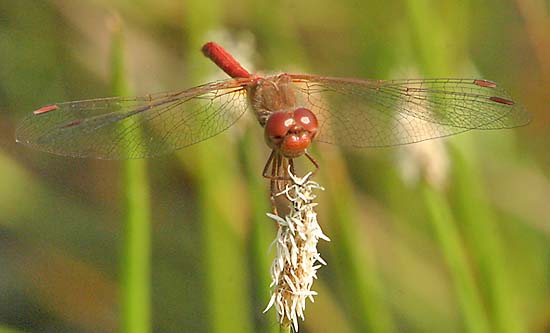 Ode for whom I jumped into the lake: Autumn Meadowhawk (right) Ode for whom I jumped into the lake: Autumn Meadowhawk (right)
At
DeSabla Reservoir in Butte Co. on 10 Sep (below), I was walking the dam
and saw what looked like a sandbar with vegetation that might be
sheltering odes in the morning (white arrow). It was just a short jump
from the dam so, loaded with camera & bins, I jumped. This was a
misjudgment. It was not a sandbar but was a floating mat. I had jumped
into the lake waist-deep. I was very wet and felt very foolish.
Fortunately it was sunny and after walking around for an hour, I was
sort-of dry. By then it was mid-day and the little meadowhawk suddenly
appeared to defend a little marshy territory along the lakeshore at the
left end of the photo (below). |
|
|
|
|

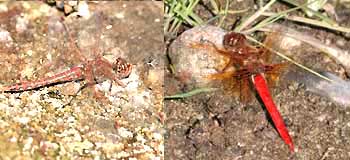
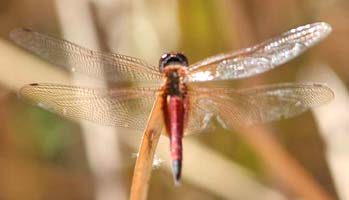
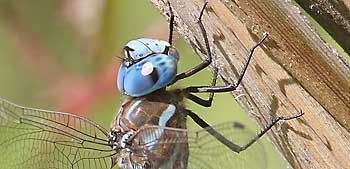
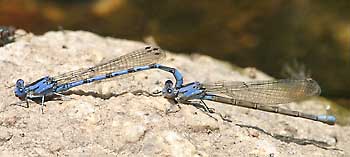
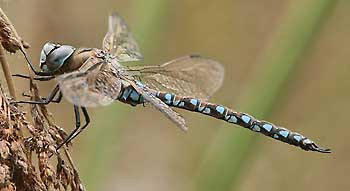
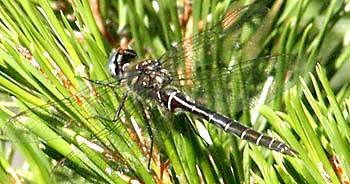
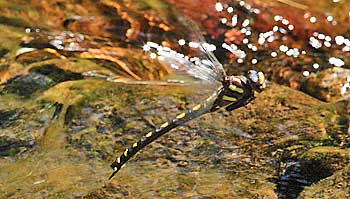
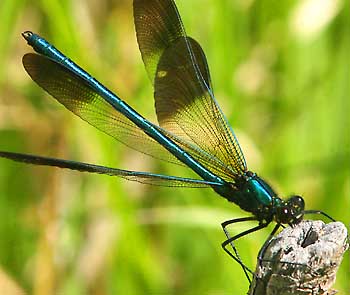
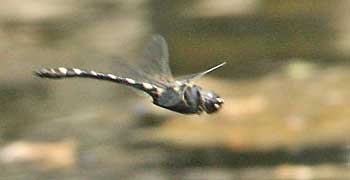


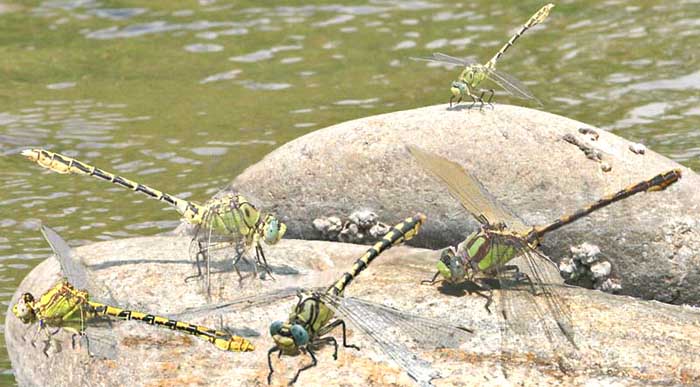
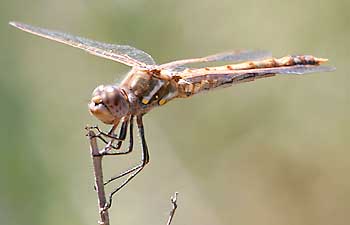
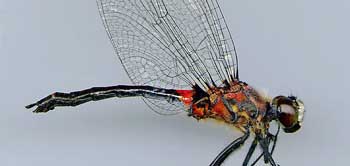
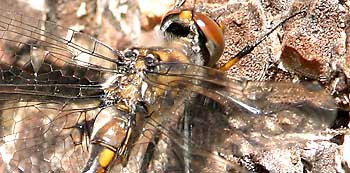
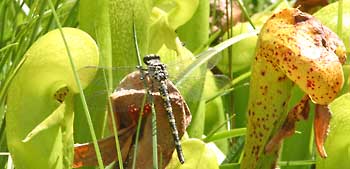
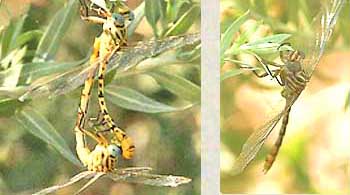

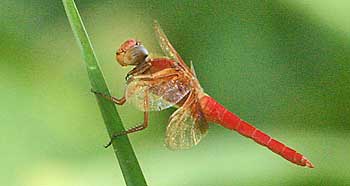
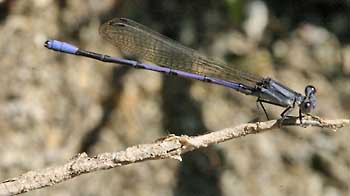
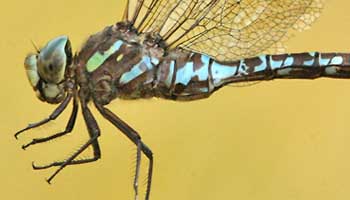


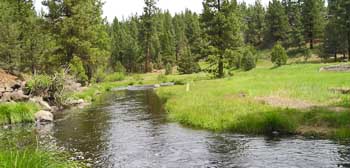
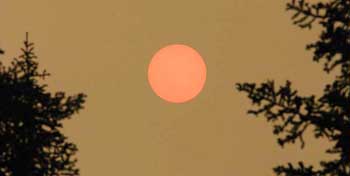
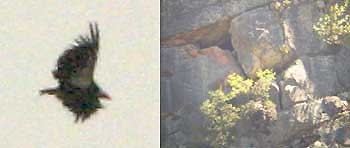
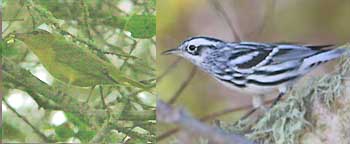

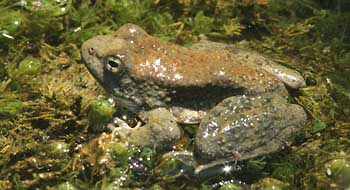

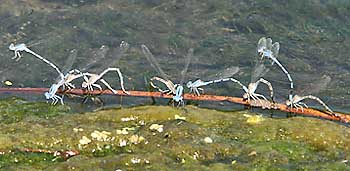
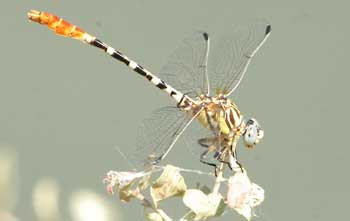
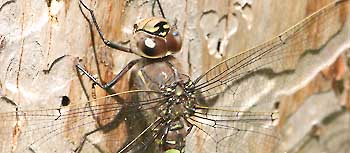
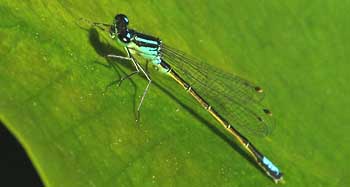
 Ode for whom I jumped into the lake: Autumn Meadowhawk (right)
Ode for whom I jumped into the lake: Autumn Meadowhawk (right) 